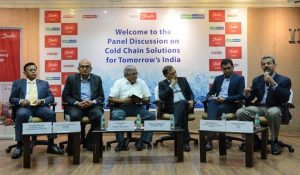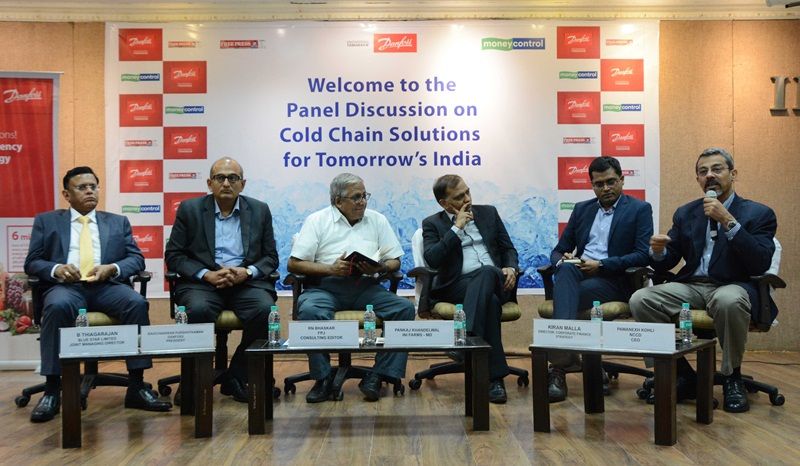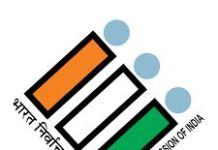http://www.freepressjournal.in/fpj-imc-forum/fpj-and-moneycontrol-forum-doubling-farmers-income-through-cold-chain/1245118
Cold chain solutions will unlock India’s agricultural wealth
— By

t is an irony for India which has a wide variety of horticultural crops, but only a very small portion of its crops moves efficiently and profitably across the nation. The cold chain industry is critical for the effective movement of these crops. It has seen investment but somehow the desired effectiveness is yet to be attained. In order to discuss the future of the cold chain, Free Press Journal and Moneycontrol recently organised a panel discussion, ‘Cold Chain Solutions for Tomorrow’s India’ at the IMC, Churchgate. The discussion looked at ways to optimise investments as well as returns from the cold chain business. Speakers on the panel were Pawanexh Kohli, CEO, NCCD; Ravichandran Purshothaman, President, Danfoss India; Pankaj Khandelwal, MD, InI Farms; B Thiagarajan, Joint MD, Blue Star and Kiran Malla, Director, Corporate Finance Strategy, EY. The discussion was moderated by R N Bhaskar with editorial support from Pankaj Joshi.
Edited excerpts:
R N Bhaskar: Cold Chain solutions is an industry that very few people talk about, and that too only in parts. We decided to focus on this topic for several reasons. We have the government saying India needs to double farmer incomes, but that cannot happen without a perspective plan and such a plan is incomplete without the cold chain solutions. I would like to begin with Pawanexh Kohli, CEO of the NCCD, the apex sector organisation, for a sectoral perspective.
Pawanexh Kohli: Thank you, and good evening, everyone. The Cold Chain is an amalgamation of separate activities working together to move value as produced, either at farm gate or factory gate, to a point where value is realised, typically the consumers. This is a conduit set of activities working to monetise a unit of value under care.
Let us have a perspective of where India stands when it comes to its infrastructure, which comprises of cold stores, reefer transport, pack houses, last-mile delivery system and distribution hubs. India has the world’s largest footprint when it comes to refrigerated warehouse spaces, or cold stores, around 130 million cubic metres, which translates to 30-35 million tonnes of storage. China, which produces twice as much as India, has around 70 million cubic metres. This should set off certain signals. America has around 150 million cubic metres of space.
Storage by itself makes no sense if you are a conduit – there has to be movement of goods. In transport, our refrigerated transport capacity is barely 4-5 million tonnes. My figures are vague, because we do not even register reefer trucks under our Motor Vehicle Act, and have to depend on industry inputs. Two years ago we had data of around 9,000 reefer trucks. Today my estimate is that we have about 12,700 actively refrigerated trucks in the country.
Pawanexh Kohli CEO, NCCD
India has the world’s largest footprint in cold stores, around 130 million cubic metres, which translates to 30-35 million tonnes of storage.
For perspective, in France, which is pretty small compared to India, has 140,000 reefer trucks, and only 15 million cubic meters of reefer space. We have almost eight times in cold space and we have less than a tenth when it comes to transport. It is a dichotomy in this space. If you produce something and then you can buffer it, but if you don’t have a means to supply, your business will suffer.
Now within this storage, today 90 per cent is used for bulk storage of potatoes, dried chillies and so on. Earlier, government policies were designed around multi-commodity cold stores. The thought was that multi-commodity means more products flowing into the chain and more opportunity to make money and recover investments. Even the subsidy mechanism was in favour of multi-commodity. But today when you do a baseline survey, you find that almost all our cold stores are designed for products which are stored at the farm gate. In reality, the majority of perishable products that we consume do not have long-term storage, like milk. I often thank God that Dr Kurien did not create cold stores for milk, but instead built a supply chain.
The cold store is like railway platforms – providing access to consumption markets. These stores are not running empty today. Our data (from the owners themselves) indicates the capacity utilisation at 75 per cent and above, is pretty good. So where is this utilisation coming from? At the start of the millennium, India imported around 20,000 tonnes of apples and this year we crossed 3, 10,000 tonnes. It is found that foreign produce like kiwis, grapes, pears etc, are accessing those stores which were created for domestic produce to access our consumers. We did not have a source point and that is where we went wrong. A supply chain has to have a point of origin and a cold storage is just a transit point. In ice-creams, the point of origin is a factory, and there you have loading points and cold stores right up to the front-end.
India is right up there in execution and optimisation of cold chain activities and has one of the greenest cold chains worldwide. However, we did not create such source points at the farm gate. Unless we have the right perspective and everything in place, the government is not going to able to do much.
In this budget, the finance minister announced the plan to create 22,000 Gramin Agricultural Markets (GrAMs), which are directly linked to creating these source points. These are not necessarily transaction points. Firstly, they will be outside the ambit of the APMC mechanism and secondly they will utilise the land which is already allocated for haats, so the land issue goes out of the discussion. Now what is needed is promotion and people participation in groups for us to solve this problem as a country.
Bhaskar: A supply chain of Amul reminds of a similar thing in another field, namely polio vaccines. Decades ago, the vaccine was produced and stored in cold environment and there was cold storage at the chemist end, but in the middle there was nothing. Hence, much of the vaccine potency was lost, till the government came forward with regulations on how vaccines had to move right from the start to the end. So maybe government policy is required sometimes to drive the industry along with investments. For a perspective on investments, I would invite Kiran Malla from Ernst & Young to give a perspective.
Kiran Malla: At the beginning, the cold chain sector was driven largely by subsidies as Pawanexh mentioned. This resulted in development of 30-35 million tonnes capacities, which was largely by unorganised/traders with some interest in the value chain or the trade of the commodities. Hence, the evolution was not holistic, which shows when you look at the products being served or the quality of facilities, or the break-up of farm produce which gets addressed by the cold chain.
Regarding investments, the best way to evaluate is look at how corporate in this space are doing. The leading name is Snowman, listed and in operations for around 25 years and still only Rs 200 crore sized company. But in the last three-four years the sector has seen much interest from overseas investors. The excitement is built around three things— low penetration, need for solutions and huge socio-political relevance related to it since farmers are linked to this sector. Agriculture is more than 25 per cent of GDP and farmer income is a boiling point or freezing point for politics.
Kiran Malla Director, Corporate Finance Strategy, EY
For the consumer, cold chain is a desirable part of logistics. In reality, it is a necessity aspect. If left to free market, will the consumer pay the cold chain cost for a better product?
When we did some studies, we found that some of this boils down to the behaviour of the Indian consumer. He may want the Mercedes Benz quality, but if given the option, would pay the value of a Nano. This in my view is a behavioural aspect. Today for the consumer, the cold chain is a desirable part of logistics. In reality, there is a necessity aspect to it. When you look at quality of vegetables, or even pharmaceuticals that we consume, it is acknowledged to be below par. The question here is what will happen if left to free market— will the consumer pay the cold chain cost for a better product? This is why traders mostly (barring high-value items like apples) would not want products to move through cold chain because they see it impacting their margins. Investors are finding this piece puzzling as there is opportunity but no willingness to pay.
A solution for this is that the government enforcement has to be stricter, more so in areas like pharma and food, with better inspection. At consumer’s end, they have to be aware of the right quality of product. Meanwhile, the traders can improve the packaging. If you look at European selling a jar of pickle, you will notice that it is packaged and labelled with details of the source. In India, companies like Adani and Reliance have tried to package it differently too.
The farmer must understand that cold chain gets higher prices and reduces wastage. Once all this awareness is in place, investment is waiting to happen. In numbers, maybe my view is that the capacity needed is 60-70 million tonnes against the 30-35 million we have.
Kohli: I beg to differ. We do not need a 60 million tonnes of capacity. The capacity the country needs is 35 million and we are within 10 per cent of that figure, because some capacity keeps going offline for ageing and infrastructure issues. Kiran also spoke about consumers not ready to pay, but if that was the case the country would not have increased its imports of perishables 14-28 times across the basket.
NCCD studies recommend that there is no need for a higher cold chain capacity except the must-do segments. When you talk about consumers for the larger bulk of cold chain movements, they are urban consumers. If you can sell your produce within a 200 km radius, anyway cold chain movement is not needed. In urban areas, people are increasingly paying more, perhaps for appeal rather than value and quality. However, today the cold chain does not grade produce by size for consumer appeal but for being packaged together for better capacity utilisation. Now the investments in cold chain are expanding beyond bulk cold stores. In fact last year almost Rs 2,000 crore of investment came in across segments, including into pack houses. Around 1.05 million tonnes capacity was created in all.
Also, cold chain has been cleared for FDI without prior approvals, and a large amount of foreign investment has already gone in. The development of the cold chain has mainly been market-led. Look at our food exports – India is the world’s largest beef exporter; third largest across meats; third largest in fish; and among the largest in grapes. I refer to exports because there cold chain is participative throughout. Similarly, we have seen imports in India growing and what consumers are paying for. For instance, the potato is not natural to India, but brought over by the British from Ireland. Thanks to one segment of the cold chain, namely cold stores, potato has become a staple national diet.
We must be clear who our consumers are and what are the price points. When we are producing more than what can be absorbed locally in the producing areas, we have to start expanding the selling cycle. The cold chain comes in here— it buys time for sale and finding a market. Then technology helps you to move where there is market, instead of waiting for market around you.
Malla: I want to clarify the point I was making, related to the aggregate produce of fruits and vegetables. If some produce are routed for local market, there is no need to move the produce through the cold chain, it obviously reduces the capacity requirements. If you look at our aggregate capacity of 30-35 million tonnes and up to 70 per cent being used for onions and potatoes, then there is an incremental demand case for other product categories in the 287 million tonnes of produce.
On the willingness part, you take any corporate in the cold chain business and see their numbers, they are all in red in terms of profits. If you talk to these corporates—Snowman or ColdEx or Kelvin, the reason their profits are in red is mainly because they do not get produce to store, the utilisation levels are low, trucks which need to run loads both ways run only one way. The breakeven price for a cold storage would be Rs 1,500-1,700 and milk gets stored at Rs 800. So, the question remains would the milk seller pay Rs 1,500. That is what I mean about price conscious customers of big market segments and not a small percentage of consumers buying imported apples. It is about the bulk of consumers willing to pay an extra rupee or two to ensure the product moves through the cold chain all throughout.
Bhaskar: Let’s go to Thiagarajan for his experiences and views.
B Thiagarajan: Through my journey, which started in 2005, I learnt that it is better to look at the positives. Today, much is being written about the problematic area in agriculture and what is not happening. Let us understand that by and large the corporate sector and city residents do not understand agriculture sector realities and how the mandi operates so on and so forth. Another learning is that in manufacturing or services, the big changes can happen very fast, say in five years. But agriculture it takes time because it is a very complex subject. Additionally, it is a state government’s responsibility, which means different policies and viewpoints everywhere. Within this, what we have achieved is very significant. We are among the top two producer nations in most fruits and vegetables. A transformation is possible right now at this stage in our journey. From the panel speakers here I learnt that there is good money to be made in fruits and vegetables, and that it is attracting investments.
B Thiagarajan Joint MD, Blue Star
In manufacturing or services, the big changes can happen very fast, say in five years. But agriculture takes time because it is a very complex subject, with different policies.
The end goal of value creation should be: farmers should get more money and consumer affordability should increase. Both can only be possible through value-addition and market expansion. There was a time when we thought FDI in multi-brand retail would be the solution and we still think it could be a solution. Meanwhile, FDI in the food processing and cold chain activity can move us towards that goal. The 22,000 GrAM initiative could be a game-changer. Similarly, more marketing knowledge the farmers and their family units acquire, the quicker the issues will get resolved. Likewise, we have to increase investments in food processing, for which fortunately industry bodies like the IMC or CII should be able to make a case easily. Processing is an employment generator and catalyst for cluster development. These are the key focus areas.
Technology wise Danfoss is a pioneer in equipment and a good amount of reduction has happened in energy consumption. A good amount of work has been done in the area of systems and operational guidelines by the NCCD. It is truly an enabler and not an authoritarian entity.
The end objective is doubling of the farmer’s income, production today is not so much of a worry. Even the farmer distress stories are connected more with overproduction. Today it is all about the forward and backward linkages up to the markets. In five years, whether multi-brand retail sees FDI or not, market will open up and all concerned will see benefits. Again the key is the 22,000 markets and the imparting of marketing knowledge to the farmers. Then we will not have youngsters thinking anything negative about agriculture sector as a career prospect.
Bhaskar: One person in this segment, has found great meaning, great relevance and great money opportunities that is Pankaj Khandelwal in InI Farms.
Pankaj Khandelwal: We offer a high-value product to global market. We sell pomegranates and bananas to retail in the US, Europe, New Zealand and that kind of thing necessitates high standards. However, I cannot sell that in India, not because of buyer unwillingness on price, but because of the lack of discipline to manage a sensitive product. In this (pomegranates) product, from the time of production to consumption, across the entire chain, it is critical to maintain a 2-5 degree temperature range. One cannot mishandle or mistreat it once it enters the cold chain, it is then a sensitive product. My export produce moves through the cold chain.
One aspect is that it is far more difficult to make money in India than outside and I have yet to crack the code of selling here. Also, channel behaviour is much better defined globally. If you export a sensitive produce to the USA, there is a three-month process, defined standards, handling techniques, trial runs, education of all those involved in the chain. In India if I go with the same product to a retailer, he would say fine, I need this tomorrow in my stores. This has happened and the product was there next day in the stores, which is fundamentally wrong.
Pankaj Khandelwal Managing Director, InI Farms
I cannot sell high value products in India, not because of buyer unwillingness on price, but because of lack of discipline to manage a sensitive product.
We had said we need 2-5 temperature and the retailer assured that. Next day I sent my person to monitor 20 stores in Mumbai and not one had that temperature maintained. We had to curtail the arrangement. My customer will pay high prices but they want standard quality. One bad out of 100 is not acceptable. Even if we deliver 99 per cent of the time, that 1 per cent failure is a brand disaster. We trained people at the retail outlets and six months later those people were no longer there. Sourcing is different – it fundamentally means dealing with a small number of farmers and high number of transactions. It is expensive but manageable.
Bhaskar: Now, we will have Ravichandran Purshothaman give his view.
Ravichandran Purshothaman: Danfoss has been working on the fruits and vegetables cold treatment for over a decade now. Our approach is to take each product separately and identify the challenges. We have classified our challenges into three sets. First is pre-harvest – even in this 287 million tonnes produce we have, we abuse resources, natural water and we do not do things the right way. Another problem is produce quality, another is the processing variety.
Now the post-harvest set. Firstly, it is not necessary that every product has to go through a cold chain. You actually have to look at who is your customer and how far away you need to take the produce. This thought process has to emerge. Traditionally in agriculture we are only producing, producing, producing. We need to move in a direction where the farmer needs to know what is he producing, when is he producing, for whom is he producing and how much quantity he needs to produce? We have to look at fork-to-farm. More value must flow to the farmer. Post-harvest techniques must also be looked into, maybe energy-intensive but then we can look at what fits the right commodity.
The third most important thing to look at is increasing value in branding. Consumers awareness is rising about what they consume – where is it produced, when, is it organic, what is the farm identity, fresh water, chemicals etc. The traceability angle becomes vital to the sales appeal and to the concept of value-addition in horticulture.
Ravichandran Purshothaman President, Danfoss India
This will be a sunrise sector, creating more jobs than software. We can create USD 3 billion or USD 4 billion in each commodity as enterprises.
If you create good practices in the pre-harvest side, build in a way that business models can reach to the right customer at right price points, coupled with branding and traceability, use technology wisely. With all these, we can create USD 3 billion or USD 4 billion in each commodity as enterprises.
I have been studying coconut as a story. Today we add value like Rs 60 per nut, whereas the figure for Indonesia and some other nations is Rs 170. The scope for value-addition is tremendous, but research and development (R&D) is needed. Our country cannot replicate models from outside. We need to build models which work in India, because India has five climatic zones. Within each zone, the agro-climatic zones are even more. So the complexity of India is to be understood only by us, we need to put more investment into R&D. We really need to innovate using low cost technologies and affordable technologies to really transform this industry.
I am as optimistic as Thiagarajan that this is going to be a sunrise sector. One, this is going to create more jobs than software. Second, what India needs right now is to create more pack houses and reefer trucks. You grade your products to A, B, C – you define your customers. We need lot of such small interventions which could be a big game changer for our farm produce.
Bhaskar: Thank you very much. Could I request one of our audience members, Pankaj Mehta to talk about transportation sector in this industry?
Pankaj Mehta: Thank you. When we talk about the cold chain in India, sadly reefer transportation or refrigerated transportation is the last piece that we think about. It is always the afterthought that we need transportation also. I represent Carrier Transicold. We only deal in transport refrigeration and have been in India for 25 years. I think the challenges, as have been discussed, are the entry points and connectivity for a nation with the problem of plenty. We need to make the farmer a marketer, once that is done he will start thinking cold chain. We as Carrier, with the support of NCCD, did a pilot project out of fruit called kinnow. It is grown in Punjab in abundance, sold on highways at cheap prices, but it did not come to Mumbai, to South India due to perishability issues. Wastage was more than 50 per cent and sale price per kg in Punjab was Rs 20. Our pilot project saw us go to the farmer. We told him that cold chain is not expensive because it adds value which customer is willing to pay for. We co-invested with the farmer, he took the fruit after pre-cooling through reefers all the way to Bangalore and it sold at an average of Rs 65 per kg and his profits went up multi-fold. His wastage was down by 70 per cent. There are success stories around but a perception change is needed.
Bhaskar: Thank you. Can I call upon one more person, Devendra Gupta, who has done work in improving energy efficiency in this sector?
Devendra Gupta: As Pankaj mentioned, the critical aspect is market linkages, return logistics, utilisation levels. We saw the farmer struggling with the post-harvest side of his work. When we provide a cooling unit to a farmer with a challenge of getting the right price, we enable him to reach out to the right markets.
Unlike milk, you do not have availability all-round the year in perishables. The harvest for 3-4 months is when those assets are utilised. In Nasik, the pre-cooling chambers are lying empty, once grapes exports are done. So we built in a lease model, made our units portable. We provide leases to farmers for three to five months and then target other commodities which do not otherwise get an entry into the cold chain. For example, litchi. If you are keeping 5,000 kilograms of Litchi pre-cooling them, rotating them in a seven-day period and paying Rs 2 per kg for 5,000, it comes to Rs 10,000 a week. If it is three rotations a month so it would be Rs 30,000 for the farmer for a facility which has hybrid of solar-thermal energy to ensure reliable operations. We have had success stories.
From my side, I would request the NCCD to promote five-Star labelled products which enhance energy efficiency. Also, we should be encouraging consumers to look at products which are sourced through cold chain for better nutrient content.
Bhaskar: Thank you, now the audience.
Audience: What is your strategy and approach to taking produce from the Northeast to the rest of the country?
Kohli: The whole story about Northeast is that it is a wonderful area, naturally fertile, chronically organic. Hence the production should have and fetch more value, because those sort of things typically are considered to be more valuable. However, value is measured at the point of delivery. The government keeps getting proposals to open up FDI in the North-East. However given the present road network and population density they have, the opportunity there does not lie in building cold stores but in either pack houses or the GrAMs. In the Northeast, contrary to normal thought, we recommend getting on to the railways for optimum movement. Luckily, the railways already reach Itanagar. There is already an operational model created and you may be aware that the Northeast already gets 15 per cent higher subsidy in the rest of the country. I talk to entrepreneurs, telling them not to listen to language which says not profitable. The whole world wants to come to India and sell in India and grow – all we have to do is connect the Northeast.
Purshothaman: Any specific proposal we are always willing to look into it. Some we are already on – like the kiwis in Arunachal Pradesh, which I think are much better than those in New Zealand. It is just the connectivity issues and as Pawanexh says, there is the need for more pack houses, segregating what goes to Delhi, to Calcutta, what can be processed. So there is a lot of work that needs to be done there. North Bengal offers similar scope.
Kohli: On the Kinnow project as mentioned, people would dump it into a cold storage, get 15 days more for a typical farm gate price of Rs 7. People would say to me, you are a fool. All the cold chain process was adding Rs 10-12 to the costs it could be sold at in Delhi. But at 2,500 km down in Bangalore the prices peaked at Rs 105, never went below Rs 45 and weighted average realisations stood at Rs 60-65. To this you add the big impact of minimised losses. The farmers became more productive in the backend. Today, third year of the project, pack houses have come up from zero to 14. There are 450 reefer trucks. We are getting ambitious.
This notion of doing 270-300 million tonnes and storage of at least 25 per cent of that production in storage is illogical. It is about throughputs, more so when production like chicken or meat is harvested daily. Would I harvest the annual output in a day and ask for storage? These are the sort of reports on 60 million tonnes of capacity needed, which push the subsidy program and the government in the wrong direction.
Purshothaman: I can give another case study where we are doing some work in Leh Ladakh. There is a lot of wastage of apricots that are grown there, especially down in the Nubra Valley upto Siachen Glacier. There, more than 40 per cent is wasted. We found that Amul supplies huge volumes of butter into Leh Ladakh, because butter tea is very popular among Ladakhi population. These trucks come back empty. None of the farmers thought about getting their produce graded, sorted and freighted on minimal cost. I think once you get into each and every geography of India, understand the current state and look at transformation, one size does not fit all. A little bit of research into the business models will actually make India better in terms of value creation.
Kohli: Let us understand that we talk about food processing – where other nations say that they process 70-80 per cent of their horticulture produce. The clothes we wear – cotton, leather – are processed. You cannot eat grain. It is processed into wheat. India produces 1.14 billion tonnes of agri-produce – around 306 million tonnes sugarcane, 300 million tonnes horticulture, 275 million food grains, 32 million tonnes oil seeds, 14 – 18 million tonnes on different meats, then you have feed, tobacco, fiber crops, cotton so on and so forth. We call it the primary sector, because you cannot use it without it being processed. When we talk of processing, especially the horticulture segment, we get lost in language. I had heard that France processes 70 per cent of their fruit and vegetable output. On talking to the French embassy, and since I had been to France, I was told this data is incorrect – France processes only 15 per cent. In France, when anything is changed – you cut it, break it, mix it, add something – it is called transformé. By that definition 80 per cent of our grapes are being processed.
Secondly, those countries rely on processed foods because they are not like India, which thrives on fresh produce and has the world’s largest concentration of vegetable eaters. If you analyse the plates of everyone, non-vegetarians and vegetarians in India, 95 per cent by mass is vegetables, fruit and vegetables; only 5 per cent is meat, including fish. Our future, solutions for the future is more about making sure value, as it is produced, we can go pre-harvest and improve everything forever. We have a certain consumption base in the country which receives foods with certain amount getting destroyed because we are not looking after it. Anything we do to minimise that, means more value being communicated, more value flowing back. When more gets communicated, prices may come down.
Audience: While using reefer truck or something to transport from one place to another place, how to ensure remotely that that particular temperature is being maintained? Do you have any automation for that?
Mehta: Yes, there is technology available, which allows you to track temperature real-time today. You also have in fact technology where you can remotely change the temperature of a truck which is moving. So, technology is available.
Kohli: It is not just temperature controls that are important. Apart from temperature controls, there should be better insulation, the optimisation of energy through logic programs, actuators and sensors, which trigger off and trigger off that is the specialty of Danfoss and others here. These are solutions for tomorrow. It is a pipeline or conduit to move goods from one place to another place, if the other place fetches you more value, it justifies your investment. For tomorrow’s solution we have to say, can it be green? Can it be more energy efficient? Will it help create new business models where India’s village connects with the global village? Those are solutions for tomorrow.















































COMMENTS